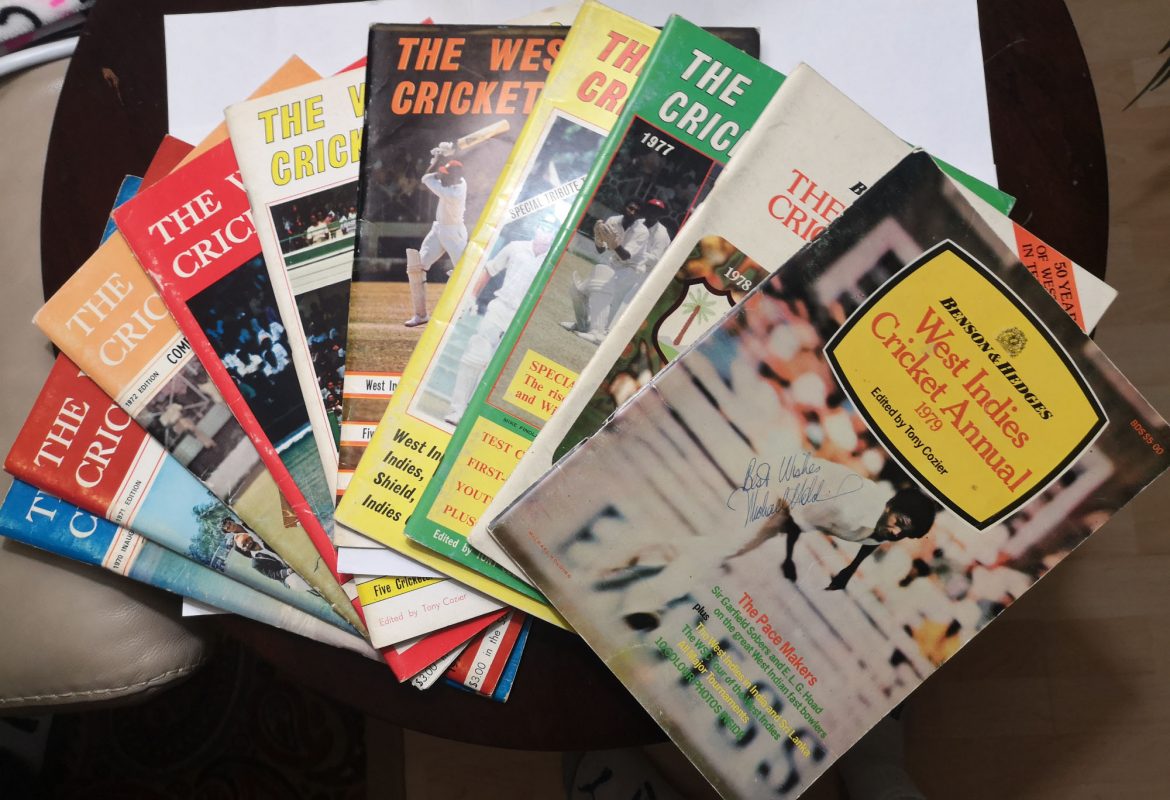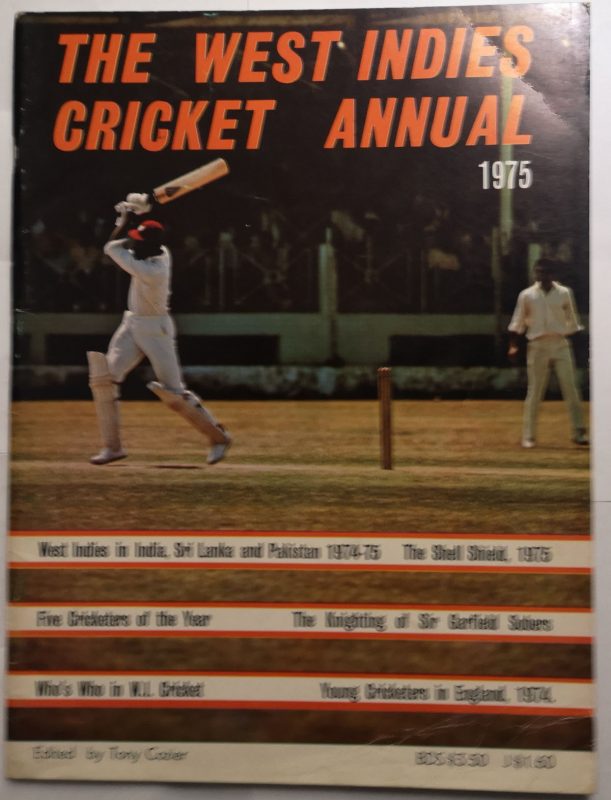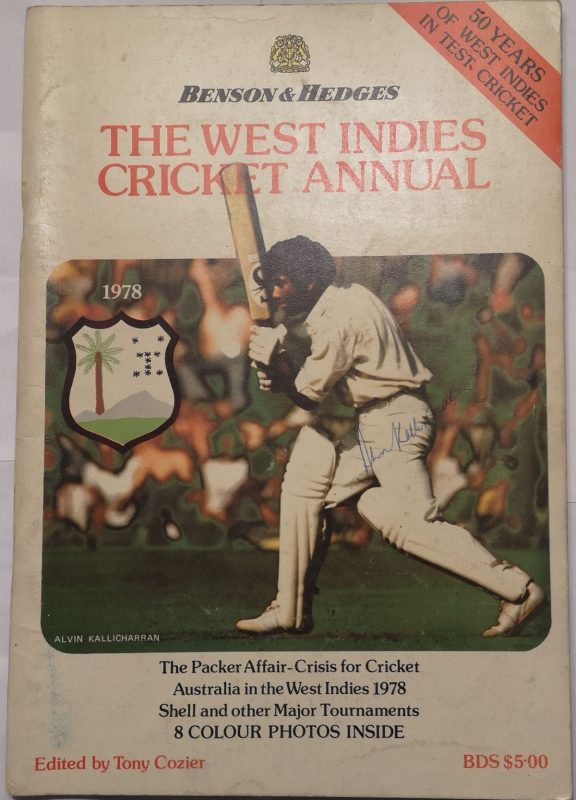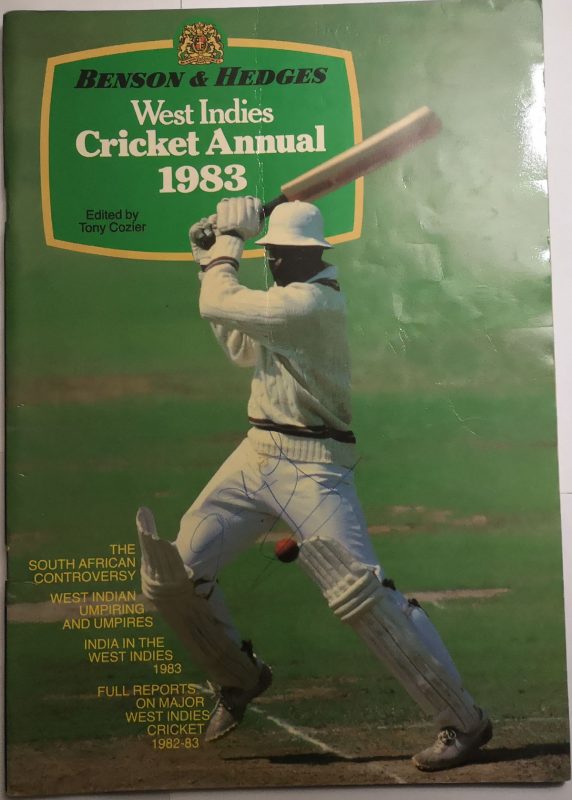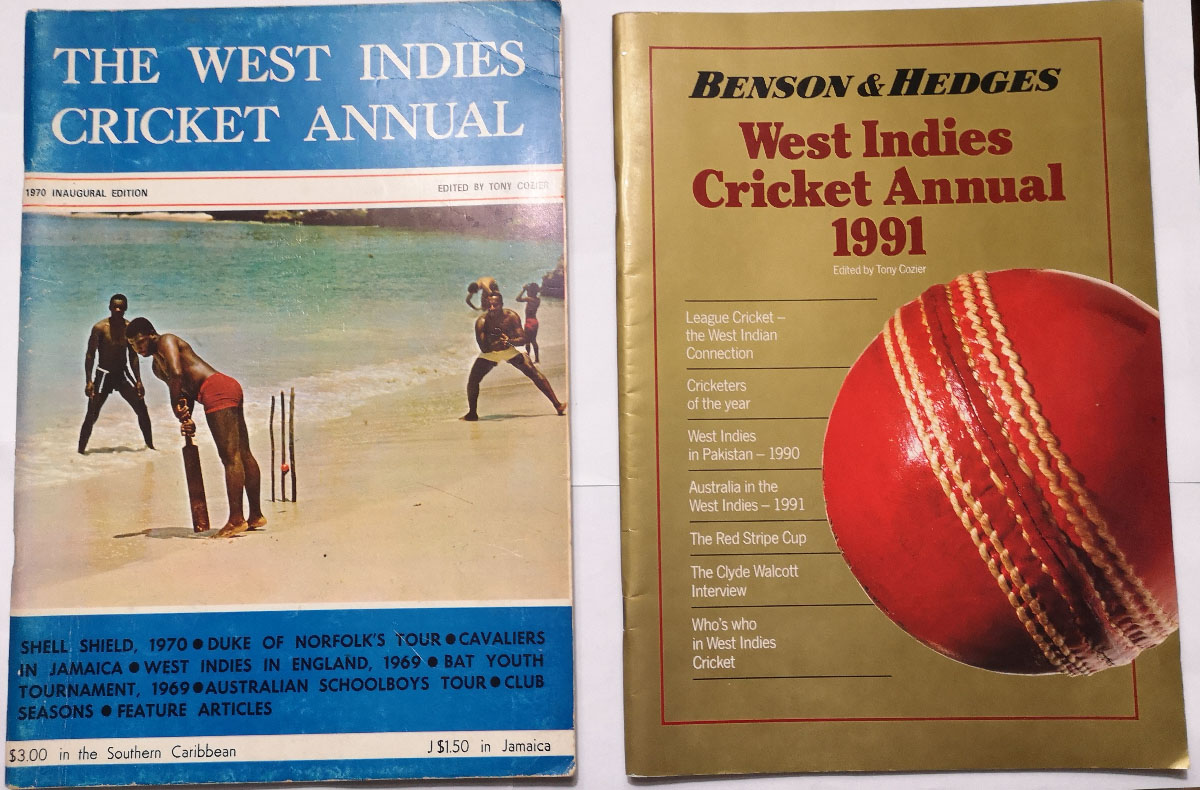By Roger Seymour
Roger Seymour revives
his truncated weekly
series, last published in September 2018
Thirty-two years ago the last edition of the West Indies Cricket Annual appeared on the shelves of bookstores, airport shops and drugstores across the Caribbean. As the paramount fount for updated information on West Indies cricket at the time, its yearly arrival in September or October was as eagerly anticipated as the first ball of a Test series in the Caribbean. As every year passes, older West Indian cricket fans, international cricket lovers, book collectors, historians and researchers continue to lament the vanishing of this invaluable source of record and documentation.
Annuals had been produced in the various territories in the past, with Jamaica and Barbados having publications dating back as far as the 1890s, but their survival was often short-lived. In fact, when the inaugural edition of the West Indies Cricket Annual was published in 1970, the only annual publication of note in the Caribbean was the Trinidad Cricket Council Yearbook, then in its seventh year. This publication, of course, focused on Trinidad’s domestic cricket competitions and West Indies’ Test series.
Late Barbadian cricket journalist Tony Cozier (1940-2016) had taken note of the expansion of the game in the region and the void of such a publication. He ventured into the field and served as the publisher/editor for the entirety of the annual’s existence. The first issue which comprised 88 pages was printed on quarto (A4) size matte paper (8.27” x 11.7”) and bound with glossy covers. The excellent cover photograph, which was to become a standard attribute of the periodical, featured beach cricket in Barbados. The caption noted that it was “a popular pastime throughout the Caribbean and played with as much fervour as the Test game is on the grounds at Sabina or Queen’s Park”. The strap line across the bottom of the front cover revealed that the cost of the publication was “$3.00 in the Southern Caribbean and J$1.50 in Jamaica.” The Jamaican dollar was amongst the strongest international currencies at that time.
The Cricket Quarterly, then known for its particularly harsh reviews of publications on cricket, flatteringly offered the following comment, “This is an excellent production and we do not recall a first issue of a cricket annual anywhere in the world at any time which has hit such a high level.”
In the editorial, captioned “Exciting times ahead for WI cricket”, Cozier alluded to the West Indies Cricket Board of Control’s (WICBC) decision to make the Shell Shield Competition, which had commenced in 1966, an annual feature, regardless of whether there was a home Test series or not, thus guaranteeing a first class season, and the continued development of the youth tournament, which had its origins in 1968.
“For the future, there is the exciting prospect of one day, knockout cricket being introduced on an inter-territorial scale and, perhaps eventually, a regional champion clubs knockout competition. Both have already been suggested and are more than just pipe dreams,” Cozier had written. Well, hindsight is 20/20, indeed, no pun intended.
The West Indies Cricket Annual, Cozier had acknowledged, “started somewhat late in the day” and was unable to provide any statistical records, apart from those in the immediate past year, or club season reports from several of the Windward and Leeward Islands, a problem which plagued the publication throughout the years. However, Cozier and the initial territorial contributors, Trinidad’s Stephen Almandoz, Guyana’s John Nestor, Jamaica’s Freddie Smith, Barbados’ Don Norville, from the Windward Islands St Aurain Seymour (St Vincent) and Rupert Branford (St Lucia) and Antigua’s Tim Hector of the Leeward Islands, laid out an excellent framework for the annual to build on.
“One feature which will be permanent in the Annual is the Five Cricketers of the Year [FCY]. We make no apology in admitting that the idea has been taken from a similar, more illustrious publication,” Cozier had penned, obviously referring to the ‘Bible of Cricket’, the Wisden Cricketers’ Almanack, which has been in print since 1864. Prefaced only by the contents page, and the Editorial or an Editor’s Note or a Comment from the publication, the FCY was always the opening bat for the annual, and invariably captured immediate attention.
The first Five Cricketers of the Year were Joey Carew, who had led Trinidad and Tobago to its first lien on the Shell Shield; Roy Fredericks (Guyana); Vanburn Holder (Barbados); Alvin Kallicharran (Guyana); and Arthur Barrett (Jamaica). No writers’ names were accredited to the tributes, an oversight which sometimes reoccurred during the history of the Annual. Although the editor had initially set out to emulate the Wisden’s lofty standard of only honouring a player once as a cricketer of the year, in 1981, Viv Richards, who had been chosen in 1975, was once again selected. The following year, the publication took the decision to remove the limitation on the number of times a player could be chosen.
The 1970 Annual included six special features, besides the FCY, ranging from an interview with then WICBC Secretary Peter Short on the functions of the WICBC, a review of the LBW Law, an in-depth look at the development of youth cricket in the Caribbean, an analysis of the West Indies Test team then in transition, a preview of the 1971 Indian Tour of the West Indies, and the rising standard of the game in the Windward and Leeward Islands. The feature articles, written by very knowledgeable West Indians, became a formidable staple of the annual over the years. Whether of a historical nature, or of an analytic perspective, these insightful pieces often provided Caribbean cricket lovers with a wider appreciation and deeper understanding of the game in the region. The documenting of various controversies or ‘bacchanal’ developments as the Trinidadians would say, which, as we well know are never in short supply, gave a unique appreciation of how difficult a task it was to be the West Indian captain or a selector.
In the initial offering, the editor surprisingly opted to place the report of the 1970 Shell Shield Season before the one on West Indies first ‘split’ Tour of England (Three-Test Series) in the 1969 summer. In the editorial, Cozier had expressed the hope that the publication would cover the preceding twelve months that coincided with the end of the first class season in the Caribbean. Over the years, this cut-off date eventually evolved to June. Beginning with the 1971 edition, the annual prioritised the Test series reports, of which there were quite often two – home and away series – over those of the regional first class season.
The comprehensive Shell Shield Report included analytical summaries of each territory’s performances, detailed batting and bowling averages, and complete scorecards of every match along with several photographs of crucial moments during the tournament. Visits by two teams from England, the Duke of Norfolk’s XI and the Cavaliers, early in the year, prior to the start of the English county season, were also well documented.
The review of the 1969 Tour of England and the reports on the Test matches set the very high standard that became one of the hallmarks of the West Indian Annual. The review, written by J S ‘Jack’ Barker, a Yorkshireman who was covering his fourth England Tour for the Trinidad Guardian, and previously published in the West Indies Chronicle, was a very matter-of-fact analysis of the selectors’ faux pas and the seemingly casual approach adopted by the West Indians. The accompanying reports allowed the reader to experience the unfolding of the Tests, the various swings in the contests and those critical moments when games are often decided. The complete scorecards of every tour match and the tour averages, which also became standard features of the annual, complemented the tour reports.
The scorecards of the 1969 British American Tobacco (BAT) Youth (Under-20) Tournament hosted and won by Trinidad and Tobago in April of that year, revealed the names of such future West Indian players as Lawrence Rowe, Bernard Julien, Larry Gomes, Inshan Ali, and David Murray. Likewise, the five pages dedicated to the 1969 Australian Schoolboys’ ten-match tour of the Caribbean, unveiled the names of future Test players Gary Gilmour, Ian Davis, Gary Cosier and Trevor Chappell.
The final pages of the 1970 Annual comprised summaries of the club seasons in the various territories and the respective tournaments in the Windward and Leeward Islands.
In spite of the sub-standard proofreading, which could have very well been the fault of the printers, who, in those pre-computer age days, were not readily known for their quality control, the 1970 West Indies Annual remains an invaluable treasure in the recording of our cricket history. Over the next few issues as the format of the publication strengthened, despite the economic problems of the 1970s that plagued the Caribbean, advertisers maintained their support, without which its survival would have been in limbo.
Significant changes over the years
Three new features appeared in the 96-page 1971 Annual. There was a detailed report of the WICBC’s AGM, an important account which became a constant of the publication. Mervyn “Pee Wee” Wong, a Trinidadian scorer and cricket statistician, provided the Territorial Partnership records for the four major territories, Jamaica, Barbados, Trinidad and Guyana. At that time, “Territorial records, especially, have proved difficult to come by,” the Annual noted. It was one of several worthy contributions made to West Indies cricket by Wong. An Obituary page noted the passing of Learie Constantine, and, after omission from the 1974 edition, obituaries became a staple of the periodical from 1975.
In 1972, the Annual was reduced to 68 pages, as the publishers strove to maintain the original sale price. The 84-page 1973 edition was printed on glossy paper for the first time and introduced an important cornerstone of future issues, the West Indies Who’s Who, the statistical records of every player from the six territories who played first class cricket in 1972 and 1973. In 1974, Wisden observed that “information which was never before available in any single publication” was readily at hand due to “Cozier’s venture”. Painstakingly compiled by Wong, details of the Who’s Who extended beyond the standard aggregates and averages, and included data such as date of birth, current club and county affiliation (where applicable), and West Indies Tours made by each player. As the game evolved over the years and the data ballooned, Wong’s passion for record keeping became an invaluable source for researchers and students of the game.
Beginning with the 1982 edition, the annual included comprehensive summaries of each Shell Shield match, and later, the Red Stripe Cup when it replaced the former in 1988. The annual remained at 84 pages until 1976, and hence after was produced with 88 pages, with the exception of the 1985 edition which contained 92 pages. With every successive year the quality control kept improving, and the errata were reduced to an infinitesimal number.
Major development
In 1978, Benson & Hedges (B&H), the cigarette manufacturer, became the principal sponsor of the annual which then became known officially as The Benson & Hedges West Indies Cricket Annual. This kind of sponsorship would not occur today, since tobacco companies are banned from advertising in the sporting world.
During B&H’s long association with the publication, which certainly extended the life of the Annual amid difficult economic times in the Caribbean, the quality of the periodical improved in many areas. Most noticeably, it was printed on a higher grade of glossy paper, thus significantly enhancing its quality. Colour photographs graced the annual for the first time in the initial sponsorship year, increasing from eight to 16 by the 1982 issue.
Of course, a major benefit of such strong sponsorship was that the periodical remained at a very affordable price to West Indies’ fans. The 1981 B&H Annual, the last one with the selling price printed on the cover cost BDS$6. A sticker price on the writer’s 1981 copy states that it retailed in Trinidad and Tobago for TT$9.20, while a similar sticker reveals that the 1987 edition sold for TT$20.
Demise and legacy
The question lingers as to the true reason for the demise of this vital organ of West Indies cricket. Neither the ‘Comment’ nor the ‘From the Editor’s Desk’ columns of the 1991 publication, the 22nd edition, even hinted that it was going to be the final issue.
In his “From the Editor’s Desk” of the 1991 Annual, Cozier wrote: “This is the 14th edition to be published under the sponsorship of Benson & Hedges. In spite of a few constraints, mainly the lack of reliable information at the lower levels of the game, the Annual has become universally accepted as an essential chronicle of West Indies cricket. I am pleased that we have managed to maintain high standards of coverage and production and recognize that this would not have been possible without Benson & Hedges’ valued involvement.”
One theory proposed for the Annual’s demise was the appearance of the Red Stripe Caribbean Cricket Quarterly in early 1991, ironically, also edited by Cozier. It also had a “From the Editor’s Desk” column and in its initial issue January – March 1991, Volume 1 Number 1, Cozier wrote: “For a multitude of reasons, West Indies cricket has never been satisfactorily chronicled. The Benson and Hedges West Indies Cricket Annual filled a vacuum when it was first published in 1970…
“The Red Stripe Caribbean Cricket Quarterly is an attempt to answer that need, to match the other Test-playing countries which each have at least one regular magazine devoted to their game. Editions will appear each January, April, July, and October carrying detailed coverage of our cricket, … all designed to complement the well-established Annual.”
After such a long and fruitful relationship, it was unlikely that Benson and Hedges would have accepted the conflict of interest created by Cozier serving as editor of both publications, and the possibility that a significant percentage of the material published in the Quarterly was going to be regurgitated in the Annual. It might be argued that the two periodicals targeted two separate consumer groups, but this was an unlikely scenario given the relatively small population base of the Caribbean.
Despite the constraints of space and other logistical difficulties such as procuring scores and reports from the various territories at times, the Annual had succeeded in providing a priceless record of the epoch of the development of West Indies cricket as it evolved into a world-trouncing force. The Annual’s legacy of high-quality pictorial content, scorecards, match reports, and features, was a reflection of the hard work of all the contributors, photographers and, not least, the editor; it remains unmatched in this region.
Today, 30-odd years since the West Indies Cricket Annual vanished, there are questions that must be asked. Is there scope for such an organ in today’s world of social media platforms and instant information? Are cricket lovers still interested in a publication of record? Is a major sponsor willing to underwrite the risk of reviving this entity? At the end of the day, the absence of such vital documentation of West Indies cricket can only be viewed as a tragedy.
Trivia question: Winston Lloyd was a frequent contributor to the features section of the West Indies Annual. Actually it was the pen name of a well-known West Indian sports writer. Do you know who he was?


